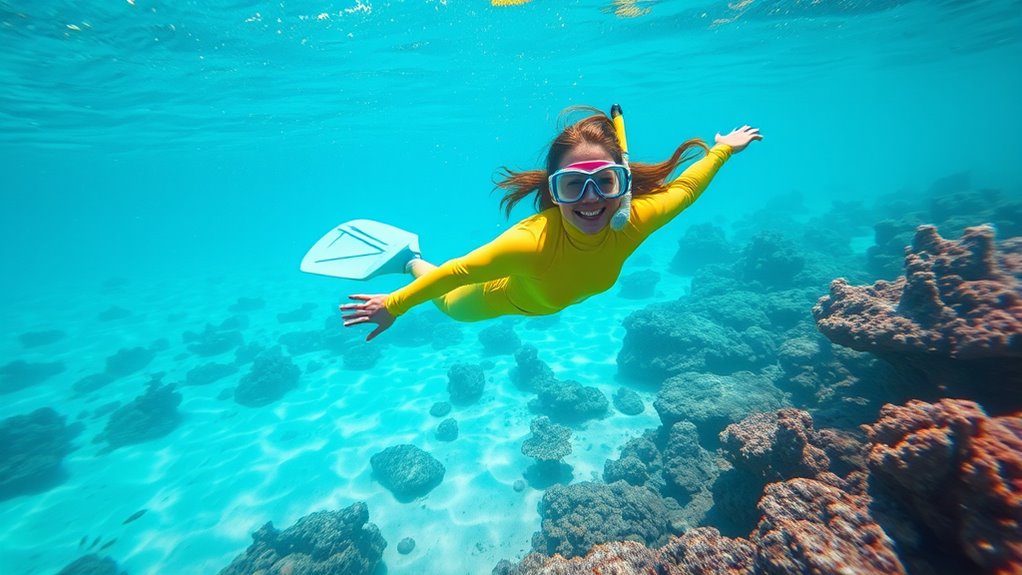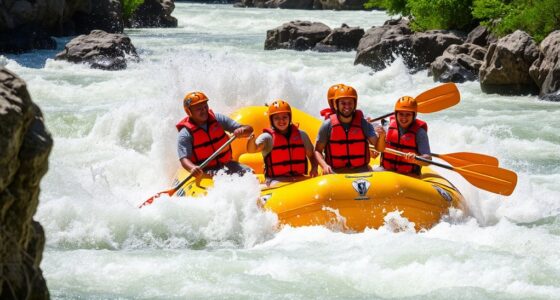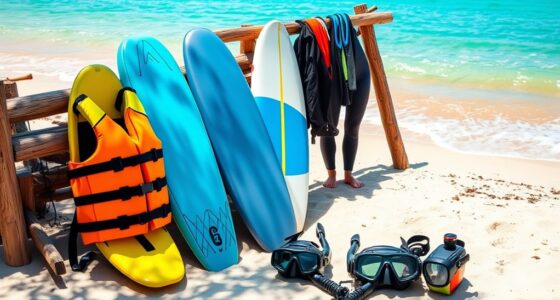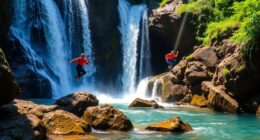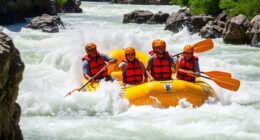If you’re new to snorkeling, it’s a simple and fun way to explore underwater life with minimal gear and skills. Start by choosing comfortable equipment like a well-fitting mask, snorkel, and fins. Practice breathing exercises, maintain relaxed movements, and stay close to a buddy for safety. Respect marine environments by avoiding contact and being mindful of currents. Interested in details? Keep exploring to discover tips for a smooth and enjoyable snorkeling adventure.
Key Takeaways
- Learn proper equipment fitting, including mask, snorkel, and fins, to ensure safety and comfort during your snorkeling experience.
- Practice breathing techniques and ear equalization to stay relaxed and prevent discomfort underwater.
- Always snorkel with a buddy, stay close to the shore, and be aware of currents and potential hazards.
- Respect marine environments by avoiding contact with coral reefs and marine life, and use reef-safe sunscreen.
- Explore diverse underwater sites to enhance skills, enjoy vibrant marine life, and deepen your appreciation for underwater ecosystems.
Why Snorkeling Is a Fantastic Beginner Activity
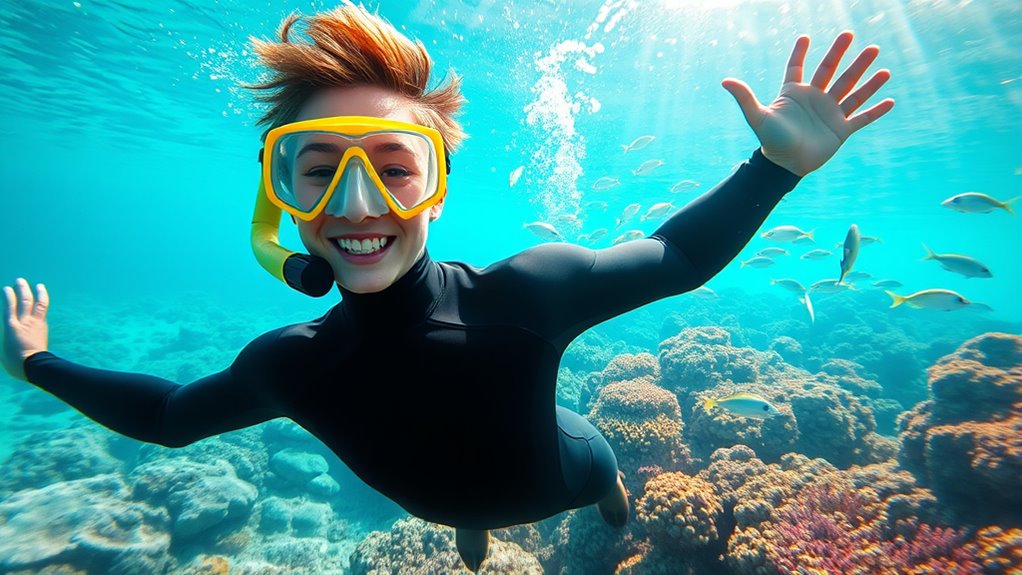
Snorkeling is a fantastic beginner activity because it’s simple to learn and requires minimal equipment. You can enjoy exploring vibrant underwater worlds without advanced training. This activity offers a close-up view of marine biodiversity, letting you observe colorful fish, coral reefs, and unique sea creatures. When practicing snorkeling safety, you’ll find it easy to stay relaxed and confident, even in open water. Staying aware of your surroundings and understanding basic safety tips helps prevent accidents, making your experience enjoyable and secure. Because it doesn’t demand extensive skills or gear, snorkeling is accessible to most beginners. It’s an excellent way to dip your toes into water sports while appreciating the richness of marine life in a safe, straightforward manner.
Essential Snorkeling Equipment You Need
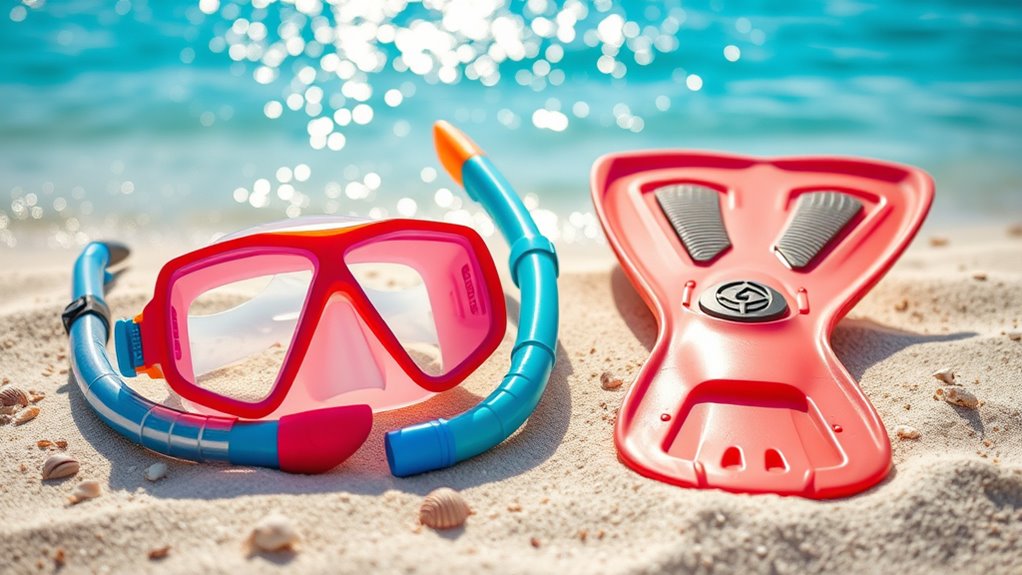
To enjoy snorkeling comfortably, you need the right equipment. A properly fitting mask creates a good seal, while choosing the right snorkel type makes breathing easier. Don’t forget fins—they help you move smoothly through the water with less effort. Maintaining your equipment and understanding emotional support can also enhance your overall experience and safety. Additionally, selecting gear with appropriate glycolic acid benefits can improve your skin’s resilience against saltwater exposure. Being aware of best equipment choices ensures you have the most suitable gear for your skill level and water conditions. Selecting equipment that suits the seasonal variations of your snorkeling location can also improve comfort and safety. For optimal image clarity and visibility underwater, using contrast ratio principles can help you choose gear that minimizes glare and enhances your experience.
Mask Fit and Seal
A proper mask fit is essential for a comfortable and effective snorkeling experience. If your mask doesn’t fit well, water leaks and disrupts your view. To guarantee a good seal, perform seal testing by gently inhaling through your nose while the mask is on. If the mask stays in place without air escaping, you have a proper mask fit. Use the table below to evaluate different mask features:
| Mask Type | Comfort Level | Seal Effectiveness |
|---|---|---|
| Silicone Skirt | High | Excellent |
| Rubber Frame | Moderate | Good |
| Hard Plastic | Low | Poor |
| Small Fit | Variable | Varies |
Additionally, choosing a mask made from high-quality materials can improve durability and comfort during your snorkeling adventures. Remember that a good seal is vital for preventing water intrusion and ensuring clear visibility. Proper mask fit not only enhances safety but also increases enjoyment by providing unobstructed views during your underwater exploration. When selecting your mask, consider the impact of material quality on overall performance and longevity. Moreover, investing in a well-designed mask can significantly reduce leakage issues, leading to a more enjoyable experience.
Snorkel Types and Use
Choosing the right snorkel is essential for a comfortable and enjoyable experience in the water. There are different snorkel types designed to suit various needs and water conditions. The classic J-shaped snorkel is popular for beginners, offering simple, straightforward use. Dry snorkels feature a special valve that prevents water from entering, making them ideal for beginners or those exploring choppy waters. Semi-dry snorkels have splash guards to reduce water entry but aren’t fully dry. When considering snorkel use, focus on comfort, ease of breathing, and how well the snorkel stays in place. Properly selecting your snorkel type guarantees you can breathe easily and stay comfortable, so you can fully enjoy your time exploring underwater life without interruptions. Additionally, understanding different tableware materials can enhance your overall experience during underwater picnics or beachside meals, especially as cybersecurity measures in online booking systems become increasingly important for safe travel planning. Being aware of safety standards for snorkeling gear can further ensure a secure and enjoyable adventure. For example, considering snorkel materials can also impact durability and comfort during extended use, which is particularly relevant given the importance of certified equipment for safety.
Fins for Mobility
Fins considerably enhance your ability to move smoothly and efficiently through the water. Choosing the right fin size is vital for maintaining fin comfort, which prevents fatigue and discomfort during your swim. If your fins are too small, you’ll struggle with propulsion; if they’re too large, you might find them heavy and difficult to control. Properly fitting fins should feel snug but not tight, allowing full range of motion without pinching. The right fin size also helps improve your overall mobility, making your snorkeling experience more enjoyable. Remember, comfortable fins enable you to conserve energy and focus on exploring underwater life. Investing in well-fitted fins tailored to your foot size ensures maximum efficiency and comfort, making your snorkeling adventures smoother and more pleasurable.
How to Choose the Right Snorkel Gear
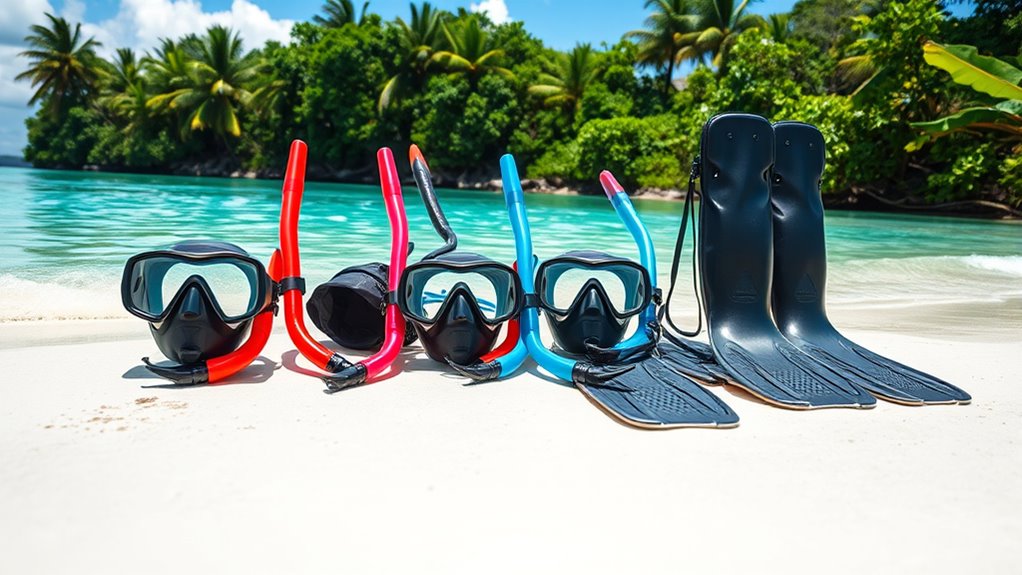
When selecting snorkel gear, it’s vital to take into account comfort, fit, and functionality to guarantee an enjoyable experience. For your mask, prioritize mask comfort by choosing a shape that fits your face snugly without pinching. A well-fitting mask prevents leaks and fogging, making your snorkel experience smoother. When selecting a snorkel, consider the snorkel length; it should be long enough to breathe comfortably but not so long that it causes water to enter easily. Look for a snorkel with a splash guard or a dry-top feature for added convenience. Make certain the mouthpiece fits comfortably in your mouth without causing fatigue. Properly fitting gear enhances your confidence and allows you to focus on exploring underwater, making your first snorkeling adventure memorable. Additionally, selecting a mouthpiece that conforms well to your bite can significantly improve comfort during extended use. Being aware of snorkel technology features can also help you choose gear that minimizes water entry and fogging issues. To further improve your experience, consider exploring mask sealing techniques to prevent leaks and ensure clear vision.
Preparing Yourself for Your First Snorkeling Trip
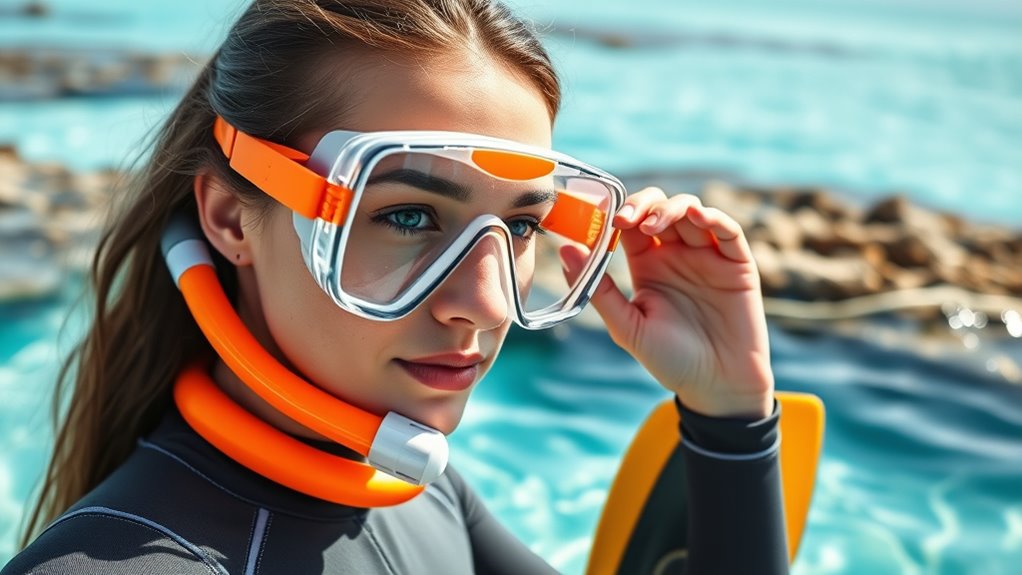
Getting ready for your first snorkeling trip involves more than just packing your gear; it’s about mentally and physically preparing yourself to enjoy the experience fully. Familiarize yourself with marine biology basics so you appreciate the vibrant ecosystem you’ll explore. Practice breathing calmly through your snorkel to avoid panic and build confidence. Planning your underwater photography shots in advance helps you stay patient and focused. To visualize, consider this simple scene:
| Scene | Marine Life | Photography Tips |
|---|---|---|
| Coral Reef | Colorful fish, corals | Use waterproof camera |
| Sunlit Waters | Schooling fish | Shoot in natural light |
| Rocky Areas | Crabs, sea stars | Keep steady and patient |
| Open Water | Large pelagics | Use wide-angle lens |
| Shallow Shore | Sea turtles, rays | Capture slow, smooth shots |
Preparation boosts your confidence, making your first snorkeling adventure unforgettable. Marine biology knowledge can greatly enhance your appreciation and safety during your trip, especially when understanding the diverse marine species you may encounter. Additionally, understanding energy efficiency principles can help you better plan and enjoy your outdoor activities sustainably, ensuring a more environmentally friendly experience. Being aware of climate control concepts, such as appropriate gear selection for different water temperatures, can also improve your comfort and safety while exploring underwater environments. Incorporating equipment maintenance routines ensures your gear remains reliable and safe for your underwater explorations.
Basic Snorkeling Techniques and Skills
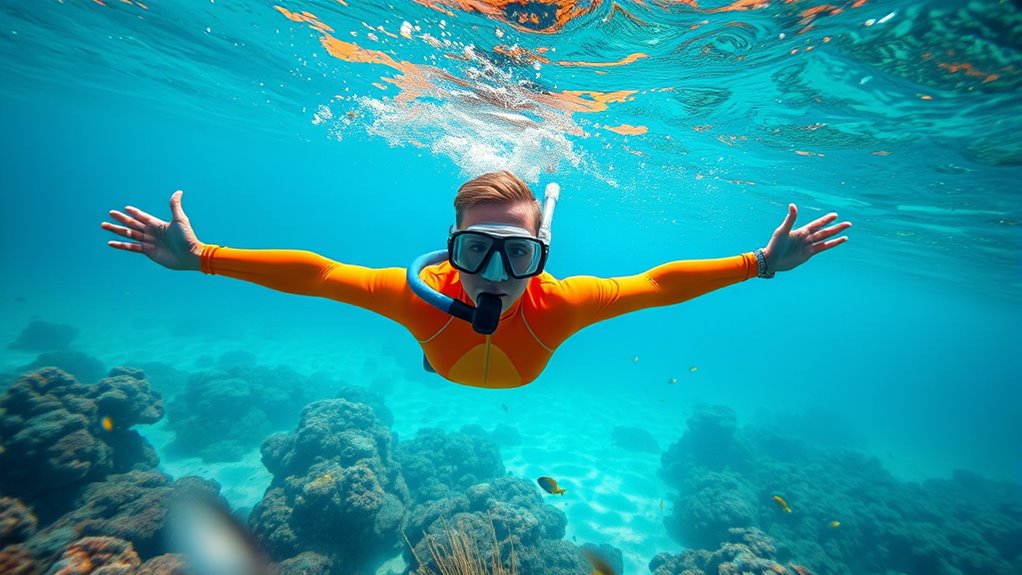
To enjoy snorkeling comfortably, you need to master breathing and equalizing techniques so you can breathe steadily through your snorkel and prevent ear discomfort. Maintaining proper fin and body position helps you move smoothly and conserve energy in the water. Practicing these skills ensures you stay relaxed and confident as you explore underwater sights. Additionally, understanding basic snorkeling techniques can significantly improve your overall experience.
Breathing and Equalizing Techniques
Mastering proper breathing and equalizing techniques is essential for a comfortable and safe snorkeling experience. Start with breathing exercises to help you relax and develop steady, controlled breaths through your snorkel. Practice slow, deep breaths to minimize fatigue and conserve air. Ear equalization is equally important; as you descend, gently pinch your nose and swallow or blow softly to equalize pressure in your ears. Doing this regularly prevents discomfort and potential barotrauma. Focus on maintaining calm, rhythmic breathing, which reduces panic and helps you stay relaxed underwater. Before entering the water, practice these breathing exercises on land. Consistent practice will make equalizing second nature, ensuring you enjoy your snorkeling adventure without distraction or discomfort.
Proper Fin and Body Position
Proper fin and body positioning are essential for efficient and enjoyable snorkeling. Good fin positioning helps you move smoothly through the water with minimal effort, reducing fatigue. Keep your fins pointed straight ahead, avoiding excessive ankle movement, to maximize propulsion. Your body should stay horizontal, with your hips and legs aligned to maintain balance and streamline your movement. Maintain a relaxed posture, keeping your head in a natural position to look downward without straining your neck. Proper body alignment helps conserve energy and allows you to glide effortlessly. Avoid excessive up-and-down movement, as it can tire you quickly. Focus on keeping your fins and body in sync, which improves maneuverability and makes your snorkeling experience more comfortable and enjoyable.
Safety Tips for a Smooth Snorkeling Experience
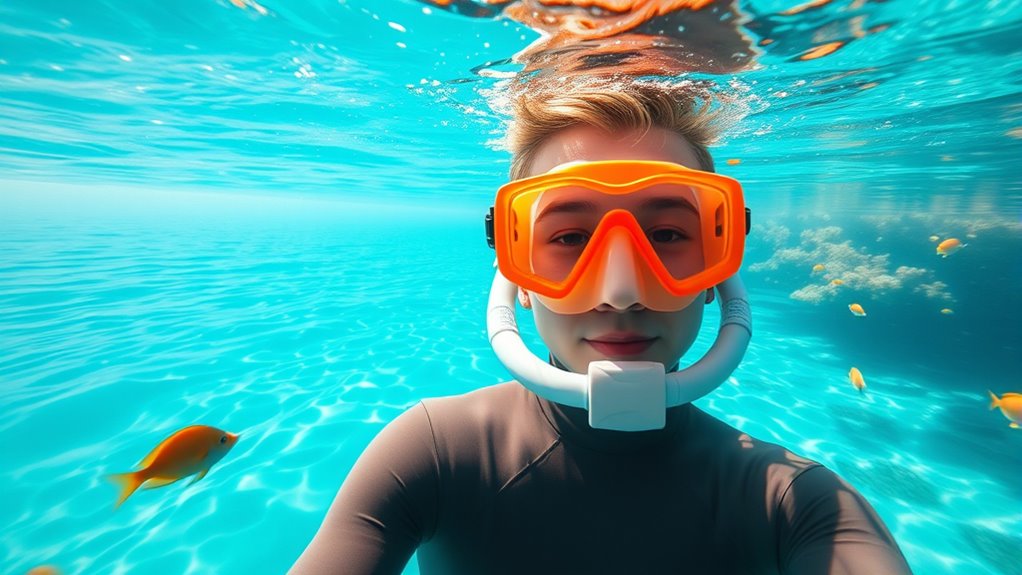
Ensuring safety while snorkeling is essential for a smooth and enjoyable experience. Always check your equipment, especially your mask and fins, before entering the water. Stay close to your buddy, especially when snorkeling with kids, to guarantee everyone stays safe. Be mindful of currents and avoid areas with strong waves. Protect your skin from the sun and consider wearing a rash guard. For underwater photography, keep your camera secure to prevent loss or damage. Here’s a quick safety checklist:
| Tip | Why it’s important | Example |
|---|---|---|
| Keep close to buddy | Prevents accidents and gets help fast | Stay within arm’s reach of kids |
| Check equipment | Ensures proper function | Test mask seal before diving |
| Respect currents | Avoids exhaustion or being swept away | Stay in calm, shallow waters |
| Use sun protection | Prevents sunburn | Wear rash guards or SPF lotion |
| Stay aware of surroundings | Prevents injuries or marine hazards | Watch out for boat traffic |
Exploring Different Snorkeling Locations
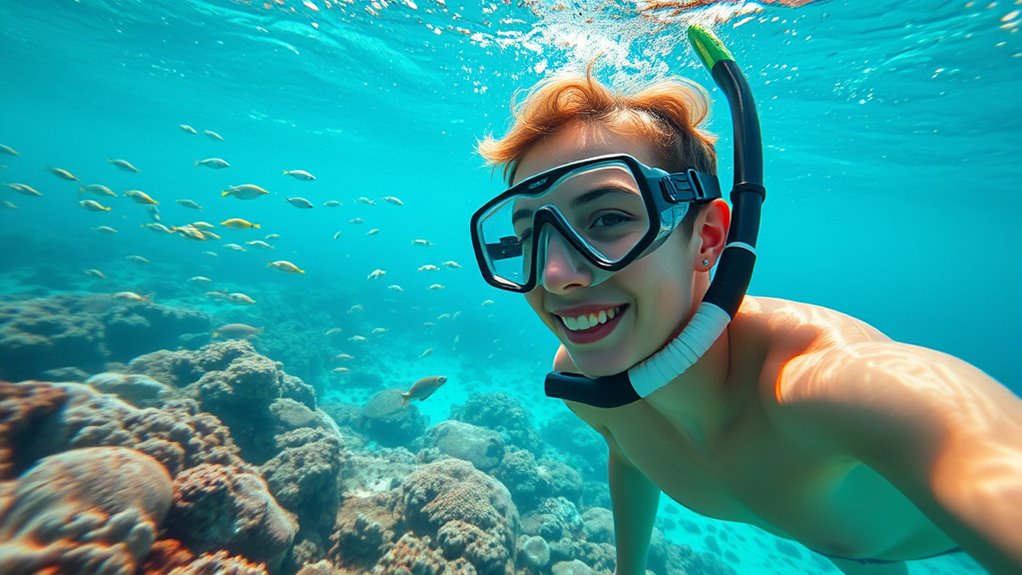
Exploring different snorkeling locations allows you to discover a variety of underwater environments and marine life. Coral reef ecosystems are vibrant, bustling habitats teeming with colorful fish, corals, and other marine creatures. Visiting various reefs and coastal areas helps you experience diverse underwater landscapes and behaviors. Some sites may offer calm, shallow waters perfect for underwater photography, while others feature dramatic drop-offs and intricate coral formations. Each location presents unique opportunities to capture stunning images and observe marine life in its natural habitat. By trying different spots, you’ll gain a deeper appreciation for the ocean’s diversity and improve your snorkeling skills. Remember, each site has its own charm, so keep exploring to uncover the richness of underwater worlds.
Tips for Respecting Marine Life and the Environment
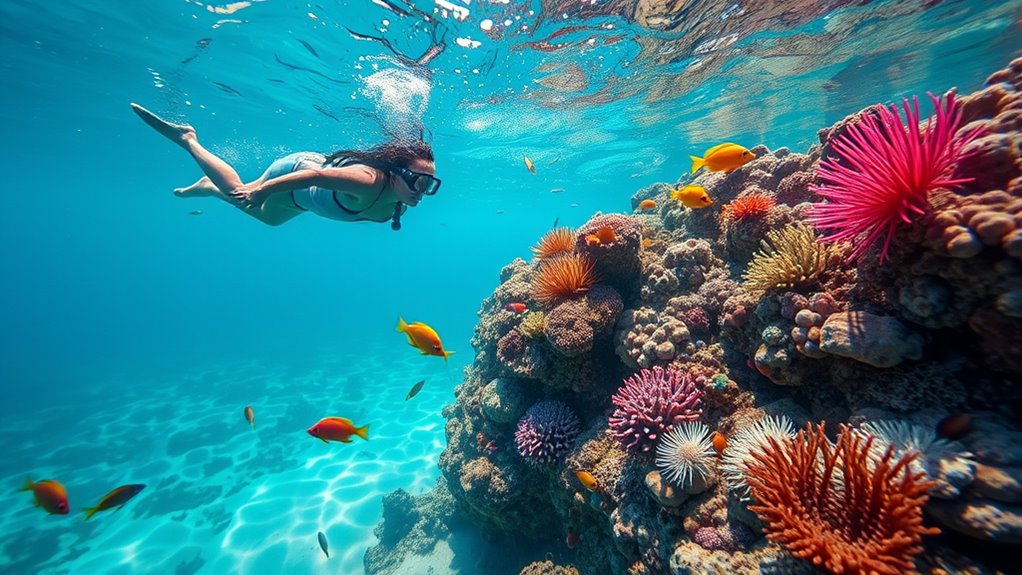
To enjoy the beauty of marine ecosystems without causing harm, it’s essential to respect marine life and the environment while snorkeling. Practice eco-friendly practices by avoiding contact with coral reefs and marine animals, as even gentle touches can cause damage. Be mindful of your fins and equipment to prevent accidental injuries to fragile creatures or coral. Remember, marine conservation starts with your actions; never disturb or feed wildlife, as it disrupts their natural behaviors. Use reef-safe sunscreen to protect both your skin and the environment. Stay aware of local guidelines and regulations, and always dispose of trash properly. By adopting these respectful practices, you help preserve the vibrant underwater world for future generations to enjoy.
Troubleshooting Common Snorkeling Challenges
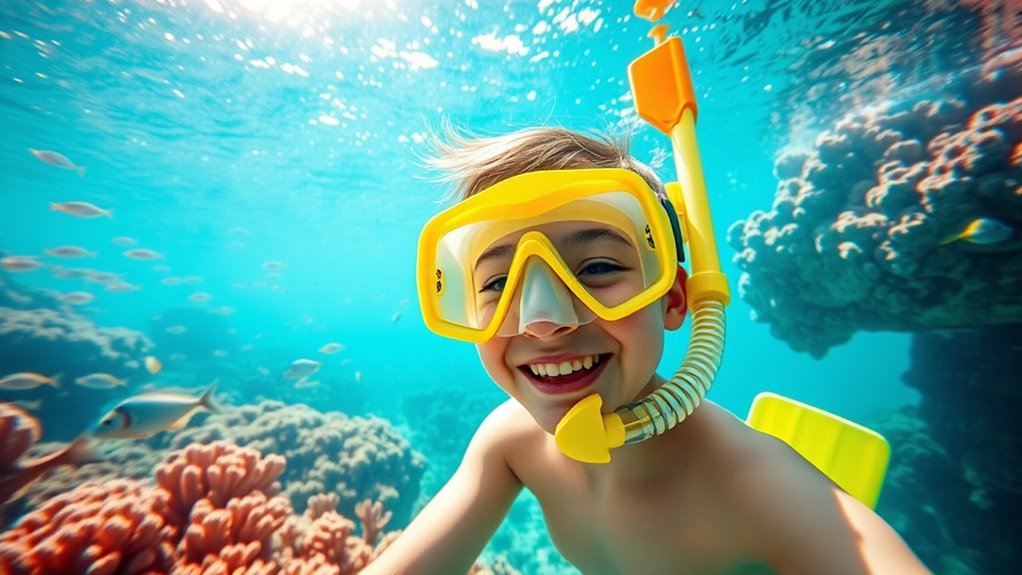
Even experienced snorkelers can encounter common challenges in the water, but knowing how to troubleshoot them can make your experience safer and more enjoyable. Mask fogging is a frequent issue; to prevent it, apply a defogging solution or spit into your mask and rinse lightly. Water leakage is another concern; ensure your mask fits snugly by adjusting the strap and sealing the skirt properly. If water seeps in, lift your head slightly and exhale gently through your nose to clear it. Check for proper mask positioning before entering the water. Practicing these simple steps helps you stay comfortable, maintain clear vision, and focus on exploring underwater life without distraction. Troubleshooting these issues guarantees a smoother, more confident snorkeling experience.
Frequently Asked Questions
Can Children Safely Snorkel With Adults?
You can definitely have children snorkel with adults, but child supervision is essential. Make sure they wear proper snorkeling gear that fits well and is suitable for their size. Always stay close and attentive, watching them closely in the water. Keep their snorkeling experience fun and safe by teaching them basic safety rules and never leaving them unattended. With proper preparation and supervision, snorkeling can be an enjoyable activity for kids and adults alike.
How Do I Prevent Fogging in My Mask?
Imagine your mask as a window to underwater worlds. To prevent fogging, think of anti fog solutions as a shield that keeps your view clear. Before diving, apply a few drops of anti fog solution inside your mask and gently spread it. Rinse lightly with water. This simple step fights mask fogging, letting you focus on the vibrant fish and coral, not blurry glass. Keep your view as sharp as your adventure calls for.
What Should I Do if I Get a Cramp?
If you get a cramp while snorkeling, stop what you’re doing and gently stretch the affected muscle to promote relaxation. Focus on muscle relaxation by slowly massaging the area and taking deep breaths. Stay hydrated before and during your trip, following hydration tips to prevent cramps. Rest in a safe spot if needed, and avoid panicking—cramps usually ease quickly with proper care.
How Long Can I Typically Snorkel at Once?
Imagine yourself gliding gracefully through crystal-clear waters, feeling free and alive. Typically, you can snorkel for about 30 to 60 minutes, but it depends on your comfort and breathing techniques. Remember to take breaks, stay relaxed, and practice proper equipment maintenance. Listening to your body helps prevent fatigue. Keep calm, breathe steadily, and enjoy each moment underwater without pushing too hard—your adventure should be fun and safe.
Are There Specific Health Considerations for Snorkeling?
When snorkeling, you should consider health factors like allergic reactions to certain marine life or sunscreen, which can cause skin issues. It’s crucial to practice sun safety by applying waterproof sunscreen and wearing protective gear to prevent sunburns. Stay aware of how your body reacts to the water and environment, and if you experience any allergic reactions, exit the water and seek medical help. Being prepared helps guarantee a safe, enjoyable experience.
Conclusion
Now that you know the basics, snorkeling becomes an exciting adventure rather than a formidable task. Think of it like learning to ride a bike—initially tricky, but with practice, you’ll glide effortlessly through underwater wonders. Embrace the journey, respect marine life, and stay safe. Just as a compass guides you through uncharted waters, your knowledge will lead you to unforgettable underwater experiences. Dive in confidently and enjoy all the vibrant beauty beneath the surface!

